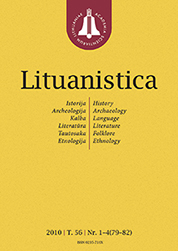LituanisticaWHAT?
 ISSN 0235-716X |
2005 m. Nr. 3 Šešėlio semantika alfonso Nykos-Niliūno poezijoje
In the poems of Alfonsas Nyka-Niliūnas
(b. 1919) the figure of shadow not only functions as a metonymy of the
human body, but it also can separate itself from the object.
As the contrast to the effects of reflection, shadow could be determined as a trace left by an obstacle in the way of light. Shadow is the inevitable satellite of man (a copy of the original thing), but in the poetical visions of dreams the ghosts and ephemeral shapes of the dead beings may lose their shadow. The inner light of mother, in the eyes of an infantile subject of Niliūnas’ early poems, was overshadowed by the metaphorical corporeal figures of destiny and death. The shadows could be characterized also by lightness, lack of weight. They move from the sphere of visual perception to the dimension of sound and are recognized in the poetical texts as the melody of a song or “childhood full of silence and sadness”. Shadows make the forms of things obscure (remind of dark blurs), emphasize the role of chromatics and bleach out the vivid colours. At a more abstract level, shadows are related to the concept of time, to the negative values of stabilization, stagnation, or even depression. A silhouette is an invariant shadow and refers to the subject’s memory of the cultural images (it is drawn or reflected in the “screen of moon”). Sometimes this figure may be interpreted as a kind of visual ornament, illusion, or a metaphor of the imagination. |
Numeriai:
2011 - T.57 Nr.1, Nr.2, Nr.3, Nr.4 2010 - T.56 Nr.1-4 2009 - T.55 Nr.1-2, Nr.3-4 2008 - T.54 Nr.1, Nr.2, Nr.3, Nr.4 2007 - T.53 Nr.1, Nr.2, Nr.3, Nr.4 2006 Nr.1, Nr.2, Nr.3, Nr.4 2005 Nr.1, Nr.2, Nr.3, Nr.4 2004 Nr.1, Nr.2, Nr.3, Nr.4 2003 Nr.1, Nr.2, Nr.3, Nr.4 2002 Nr.1, Nr.2, Nr.3, Nr.4 2001 Nr.1, Nr.2, Nr.3, Nr.4 |